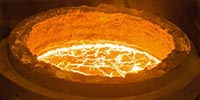Advanced Engineering ceramics
The term advanced ceramics has been used since 1970 for new engineering materials. There has been tremendous growth in the technical development of these materials since then. A report predicts that the advanced ceramic market will reach $ 10.4 billion by 2021. This growth is due to the increasing use of advanced ceramics as an alternative to metals and plastics in the medical, electronics and transportation industries.
Advanced ceramics are an integral part of modern technology. There are reports that the cost of producing ceramics is lower than that of metals, and stocks of raw materials for ceramics are abundant. The source of metals and their alloys is declining, and the steady demand for engineering products requires the identification of other materials. In the last few decades, advanced ceramics have had important applications in everyday life. For example, without spark plugs made of alumina ceramic (AL2O3), car technology would not be very advanced, in addition, metallurgy without refractory materials would not be very reliable. Although ceramics play an important role in a number of technologies due to their unique combination of properties, as structural materials, they still face stiff competition from cheap metals, alloys, and composites. Thus, the major obstacles to the widespread use of advanced ceramic materials are the lack of specifications and databases, large-scale costs, and the lack of repair methods. However, much progress has been made over the years to reduce these cases.
The range of products of advanced engineering ceramics is very wide and these ceramics can perform in special environments such as corrosive environments, high temperature, high wear rate, high stresses, need for dimensional stability, high thermal shocks and high electrical currents. These ceramics are divided into two general categories:
Dense ceramics: protective coatings, spray nozzles, electrical insulators, oil, gas and petrochemical components, ball mill, liner and ….
Porous ceramics: petrochemical catalysts, filters, ultrafiltration membranes
The microstructure of advanced engineering ceramics and their final properties depend on the following:
Powder properties: grain size, grain size distribution, specific surface area, pH, additives and crushing method
Forming method : Press, Slurry casting, Jelly casting, Extrusion, Mold injection, Tape casting
Sintering parameters: (baking temperature, oven atmosphere)
Some of these applications are listed in the table below:
| Alumina product code | ||||
| FC2 | FC60 | FCG-60 | ||
| √ | √ | Abrasion resistance ceramics: abrasives and liners, ceramic pellets
Sandpaper |
||
| √ | Dielectric ceramics | |||






